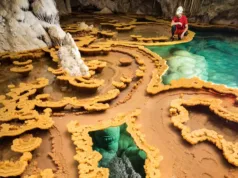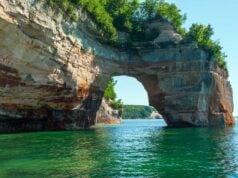Las Coloradas is a unique and visually stunning site located in the state of Yucatan, Mexico. It is renowned for its vibrant pink-hued lakes that captivate visitors from around the world. The geology of Las Coloradas plays a significant role in creating this breathtaking natural phenomenon.




Las Coloradas is situated along the northern coast of the Yucatan Peninsula, near the town of Río Lagartos. The region is characterized by its flat topography and limestone bedrock, which is common throughout the Yucatan Peninsula. The Yucatan Peninsula is primarily composed of a massive limestone platform known as the Yucatan Platform or the Yucatan Shelf.
The Yucatan Platform was formed during the Late Cretaceous period, approximately 65 to 100 million years ago, when the area was covered by a shallow sea. Over millions of years, the accumulation of marine sediments, including coral reefs, shells, and other organic materials, led to the formation of the limestone rock that comprises the Yucatan Peninsula today.
One of the key factors that contributes to the distinctive pink color of the lakes in Las Coloradas is the presence of high concentrations of salt and minerals, particularly sodium sulfate and calcium carbonate. These minerals are brought to the surface through a combination of underground water sources and the effects of evaporation.
Las Coloradas is situated within the Ría Lagartos Biosphere Reserve, which is a protected area known for its rich biodiversity, including numerous species of birds, fish, and other wildlife. The reserve encompasses a network of estuaries, mangroves, and wetlands, creating a unique ecosystem that supports a wide range of flora and fauna.
The pink lakes of Las Coloradas owe their vibrant color to the interaction between the mineral-rich waters and the microscopic algae and bacteria present in the lakes. These microorganisms thrive in the high-salinity environment and produce pigments that give the water its distinctive pink color.
The pink lakes of Las Coloradas have become a popular tourist attraction, drawing visitors who are mesmerized by the surreal beauty of the landscape. Visitors can observe the vibrant pink hues up close and even take guided tours to learn more about the geology, ecology, and cultural significance of the area.
It is important to note that while Las Coloradas is a natural wonder, it is crucial to respect the delicate ecosystem and follow responsible tourism practices to preserve the site for future generations to enjoy.
Pink Salt Lakes
The unique pink color of the salt lakes in Las Coloradas is primarily caused by the presence of certain microorganisms, particularly algae and bacteria. These microorganisms produce pigments that give the water its vibrant pink hue.
The formation of the salt lakes begins with the geological composition of the area. The region sits atop a limestone platform, which is rich in minerals such as sodium sulfate and calcium carbonate. Underground water sources carry these minerals to the surface, where they accumulate in shallow, salty pools.
The high salinity of the water creates an extreme environment that is inhospitable for many forms of life. However, certain microorganisms, known as halophiles, have adapted to thrive in such conditions. These microorganisms include various species of algae and bacteria that have specialized pigments, such as carotenoids, which give them the ability to survive and multiply in the high-salinity environment.
As the microorganisms multiply, they form dense populations in the lakes, resulting in a phenomenon called “blooms.” These blooms can vary in color, ranging from pink to red or even orange, depending on the specific types and concentrations of microorganisms present.
The pigments produced by the microorganisms serve a variety of purposes. Some pigments act as protection against the intense sunlight and UV radiation in the region, while others help the microorganisms absorb light for photosynthesis. These pigments, particularly the carotenoids, are responsible for the pink coloration of the water.
The ecological importance of these microorganisms in the salt lakes of Las Coloradas is significant. They form the base of the food chain, providing a source of nutrients for other organisms, such as certain species of shrimp and birds that feed on them. The lakes also support a diverse array of bird species, including flamingos, which are attracted to the rich food source provided by the microorganisms.
Furthermore, the salt lakes in Las Coloradas are part of the larger ecosystem of the Ría Lagartos Biosphere Reserve. The presence of these unique lakes contributes to the overall biodiversity of the reserve, providing habitats for a variety of species of birds, fish, and other wildlife.
It is important to note that the delicate balance of the ecosystem in Las Coloradas relies on maintaining the appropriate conditions for the microorganisms to thrive. Any disruption to the natural processes or excessive human intervention could have negative consequences for the ecosystem and the vibrant pink lakes. Therefore, it is crucial to practice responsible tourism and conservation efforts to preserve the ecological integrity of Las Coloradas.
Tourism and recreational activities around the salt
Tourism and recreational activities around the salt lakes of Las Coloradas have become increasingly popular due to the unique and mesmerizing pink landscapes. Visitors have the opportunity to engage in various activities that allow them to explore and appreciate the natural beauty of the area. Here are some of the tourism and recreational activities available:
- Guided Tours: Local tour operators offer guided tours of the salt lakes, providing visitors with insights into the geology, ecology, and cultural significance of Las Coloradas. These tours often include visits to different parts of the lakes, allowing visitors to witness the striking pink hues up close.
- Photography: The surreal and vibrant pink lakes offer photographers an extraordinary opportunity to capture stunning and memorable images. The contrast between the pink water and the surrounding white salt formations creates a visually striking setting for photography enthusiasts.
- Birdwatching: The salt lakes of Las Coloradas attract a diverse range of bird species, including flamingos, herons, egrets, and many others. Birdwatching enthusiasts can observe these beautiful creatures in their natural habitat, capturing unique bird sightings and behaviors.
- Boat Tours: Boat tours are available in the nearby Río Lagartos area, allowing visitors to explore the estuaries, mangroves, and wetlands surrounding Las Coloradas. These tours offer opportunities to spot wildlife such as crocodiles, dolphins, and various bird species.
- Salt Lake Swimming: While swimming is not permitted in all areas of the salt lakes, there are specific designated spots where visitors can safely enjoy a swim. These areas typically have less salt concentration, allowing for a refreshing dip in the pink waters.
- Relaxation and Beach Time: Along the coast of Las Coloradas, there are pristine sandy beaches where visitors can relax, sunbathe, and enjoy the tranquility of the area. The scenic beauty and peaceful atmosphere make it an ideal spot for a day of leisure.
- Local Culture and Cuisine: Exploring the nearby town of Río Lagartos provides an opportunity to experience the local culture and sample traditional Yucatecan cuisine. Visitors can try delicious seafood dishes and interact with the friendly locals.
It’s important to note that while enjoying these recreational activities, it is crucial to follow responsible tourism practices and respect the natural environment. This includes avoiding littering, keeping a safe distance from wildlife, and adhering to any guidelines or regulations set by local authorities to preserve the ecological integrity of the salt lakes and surrounding areas.
FAQs
How do the salt lakes of Las Coloradas get their pink color?
The pink color of the salt lakes in Las Coloradas is primarily due to the presence of microorganisms, such as algae and bacteria, that produce pigments, particularly carotenoids. These pigments give the water its vibrant pink hue.
Can you swim in the salt lakes?
Swimming is generally not permitted in all areas of the salt lakes. However, there are specific designated spots where visitors can safely enjoy a swim. These areas typically have lower salt concentrations, allowing for a more pleasant swimming experience.
Are the salt lakes natural or man-made?
The salt lakes of Las Coloradas are natural formations. They are a result of geological processes, including the accumulation of minerals and evaporation, combined with the presence of microorganisms that give them their unique pink color.
Can I take a guided tour of the salt lakes?
Yes, guided tours are available in Las Coloradas. Local tour operators offer guided tours that provide insights into the geology, ecology, and cultural significance of the area. These tours often include visits to different parts of the salt lakes, allowing visitors to witness the pink hues up close.
What other attractions are there in Las Coloradas?
Apart from the salt lakes, Las Coloradas is located near the Ría Lagartos Biosphere Reserve, which is known for its diverse ecosystem and abundant wildlife. Visitors can explore the estuaries, mangroves, and wetlands, where they may encounter various bird species, crocodiles, dolphins, and more.
How can I get to Las Coloradas?
Las Coloradas is located on the northern coast of the Yucatan Peninsula in Mexico, near the town of Río Lagartos. The nearest major airport is Merida International Airport (MID), from where you can arrange transportation to Las Coloradas, either by renting a car or hiring a taxi or private transfer.
Is Las Coloradas safe for tourists?
Las Coloradas, like any other tourist destination, is generally considered safe for tourists. However, it is always advisable to take common-sense precautions, such as keeping an eye on your belongings, following local laws and regulations, and being aware of your surroundings.
Can I see flamingos in Las Coloradas?
Yes, Las Coloradas is known for attracting flamingos. The salt lakes provide an ideal habitat for these majestic birds. Visitors have the opportunity to observe flamingos and other bird species in their natural environment, making it a popular spot for birdwatching enthusiasts.
What is the best time to visit Las Coloradas?
The best time to visit Las Coloradas is during the dry season, which typically runs from November to April. During this time, the weather is generally pleasant, with lower chances of rain. However, the salt lakes maintain their pink color throughout the year, so you can visit at any time to enjoy the unique beauty of the area.
Are there accommodations available near Las Coloradas?
While Las Coloradas itself is a small town with limited accommodation options, the nearby town of Río Lagartos offers a range of hotels, guesthouses, and eco-lodges to cater to tourists. It is recommended to book your accommodations in advance, especially during peak tourist seasons, to secure your preferred choice.




































